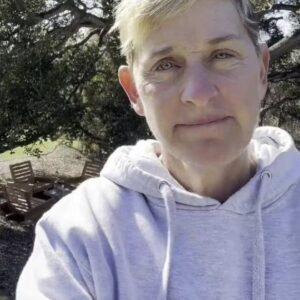I never imagined a late-night run for duct tape and batteries would completely upend my week—maybe even my life. I wasn’t in the mood for surprises or mysteries. My landlord had just told me he was raising the rent—again—and the only thing stopping me from channeling my frustration into a full-blown cleaning frenzy was a broken drawer slide in the kitchen. That’s why, at exactly 9:47 p.m. on a Wednesday, I found myself at Harlow’s Home & Hardware.
It was that hour of the night when the world feels quieter, like it’s exhaling. The store was nearly empty. Shelves half-stocked, the occasional beep of a scanner echoing through the aisles, and some old song playing faintly overhead. It smelled like sawdust and shrink wrap—nothing unusual. It could’ve been any hardware store in any small town.
I wasn’t even close to the duct tape aisle when I saw her.
A dog. Medium-sized. Sandy fur, slightly droopy ears, and a tail curled neatly by her side. She was sitting right in the middle of the aisle, beside the step ladders and extension cords. Her leash—a worn black one—trailed behind her on the white tile floor.
I froze.
She looked at me.
Not scared. Not anxious. Just… aware. Like I was interrupting something private. Or maybe like I was exactly who she’d been waiting for.
I stepped forward slowly. She didn’t move. Her eyes—deep brown with a glint of gold—were calm. Steady. Patient.
I knelt down.
“Hey, girl,” I whispered, extending my hand. “Where’s your human?”
She tilted her head and gave one slow wag. Not playful. Just… responsive.
Her collar was made of old leather—cracked at the edges but clean and clearly cared for. I turned over the tag hanging from it.
One word.
Hope.
No phone number. No address. No scratches or faded paint on the tag. It looked almost brand new.
I stood and glanced around.
Nothing. No sounds. No one calling for their lost dog. Just silence stretching longer and heavier by the second.
I walked to the front counter, holding her leash gently. She followed close behind, quiet and obedient.
The cashier—young, with a lip ring and bleached buzzcut—raised her eyebrows as I explained.
“Nope,” she said, grabbing the PA mic. “Nobody’s mentioned a missing dog.” After making the announcement, she asked, “She chipped?”
“I don’t know,” I said. I glanced back. The dog—Hope—was lying calmly by the sliding doors like she belonged there. “Her tag just says… Hope. That’s it.”
The cashier nodded. “That’s her.”
I blinked. “You know her?”
“Sort of.” She looked at her coworker, an older man stocking batteries. “Trevor, isn’t that the dog that shows up sometimes?”
He scratched the back of his neck. “Yeah. I’ve seen her a few times. Maybe more. She comes in, sits around for a while, then leaves.”
“Alone?” I asked.
“Always.”
“How long does she stay?”
He shrugged. “Hour or two. Like she’s waiting for someone.”
Then the cashier said something that chilled me.
“She only comes on Wednesdays.”
My skin prickled.
“Every week?” I asked.
“Not weekly, but always on a Wednesday. Late. Quiet. Like tonight.”
I looked back at Hope.
Still watching.
Still waiting.
There was no way I could leave her there. She looked like she’d been forgotten. Like no one else was going to step in. So I did.
I brought her home.
My apartment was tiny—half-assembled IKEA furniture, laundry in piles. But Hope didn’t care. She walked in like she’d lived there for years. Circled the living room once, then curled up on the rug and fell asleep.
No barking. No pacing. No fear.
Just peace.
The next morning, the vet confirmed she wasn’t chipped. She was healthy. About six years old. No records of a lost dog matching her description.
I got her a new leash, a tag with my phone number, and told myself I’d post flyers, ask around. But deep down… I didn’t want anyone to come forward.
In the days that followed, life felt different. Better. I had a rhythm again—morning walks, evening snuggles. Less mindless scrolling. More living. Hope was grounding. Quiet, but constant.
When my anxiety flared, she nudged me. When I worked too late, she brought me her leash.
She gave me structure. Purpose.
Then, two weeks later—on a Wednesday—something strange happened.
At 9:30 p.m., she sat by the door. Not whining. Just waiting. I figured she wanted a walk. I clipped the leash and let her lead.
But she didn’t go toward the park. She tugged me down Main Street. Past the diner. Past the garage.
Back to Harlow’s.
She sat in front of the doors.
Waiting.
We waited together.
No one came.
But as we turned to leave, I saw something I hadn’t noticed before—a bulletin board near the entrance.
Among lost-cat posters and babysitter ads was a photo, yellowed and slightly crooked.
A woman. Smiling. Arm around a dog that looked exactly like Hope.
Below it, written in faded marker:
IN LOVING MEMORY OF MARIA ELLISON
1974–2021
“She always believed in second chances.”
The next day, I asked Trevor.
He remembered Maria. Said she used to come in every week. Always with Hope. They’d sit and people-watch. Everyone in the store knew them.
“She died in a car accident,” he said. “Three years ago. After that, the dog just disappeared.”
It hit me then.
Hope hadn’t been waiting for someone. She’d been waiting with someone—in her memory. She came back to the last place they were together.
A ritual of loyalty. A habit formed from love.
I sat in the car, Hope curled next to me, thinking about how we assume closure comes naturally.
It doesn’t.
Sometimes, you have to choose it.
That night, I gave her something new—not just a home, but a reason. We started volunteering at the senior center together. Her calmness brought out light in people. Stories. Smiles.
She wasn’t waiting anymore.
She was giving.
And so was I.
If this story moved you, share it. Maybe someone out there is still searching for their Hope.





